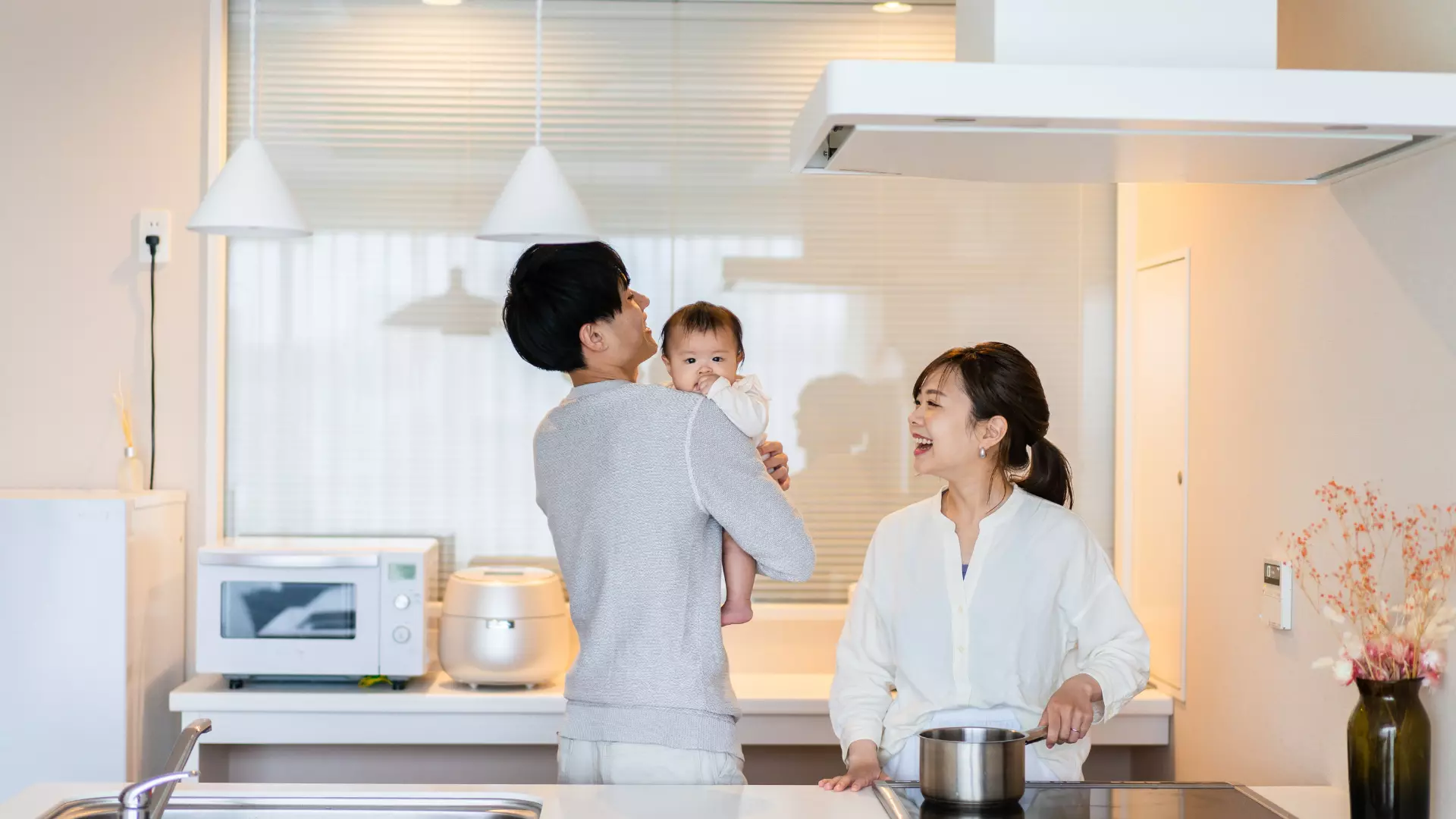What is a childcare share house?
A child-rearing share house is a style of housing where parents live together and support each other in raising their children. Unlike a typical share house, it is characterized by an environment that is designed with child-rearing in mind. Since parents can share child-rearing and housework responsibilities, it not only reduces the burden of single parenting, but also encourages natural interaction between children.
Shared houses have common spaces such as living rooms and kitchens, allowing residents to deepen their interactions with each other on a daily basis. In particular, having an environment where parents can consult with each other while watching over their children provides a great sense of security when it comes to child-rearing. For dual-income families and single parents, child-rearing shared houses are gaining attention as one of the ideal living environments.
Differences from traditional home childcare
In the past, it was common for parents to take on the responsibility of raising their children alone. Especially in urban areas, the trend towards nuclear families is increasing, and there are many cases where there are no relatives nearby to rely on, so the burden of childcare tends to be concentrated on one parent. Single parenting increases the mental and physical burden, and many parents feel lonely when raising their children.
On the other hand, in a childcare share house, multiple parents support each other in childcare, making it possible for them to help each other on a daily basis. For example, other residents can watch over the children during busy times, allowing parents to have time to concentrate on housework or work. In addition, children can play in shared spaces, creating an environment where they can feel safe without parents having to be there all the time.
Furthermore, children will have more opportunities to interact with children and adults of different ages, which will help them develop social and communication skills in a natural way. Another benefit is that they can learn diverse ways of thinking by interacting with adults who have different values.
In this way, compared to traditional child-rearing at home, a child-rearing share house is an environment that offers many benefits to both parents and children.
Why childcare share houses are gaining attention in Japan
There are several social and economic factors behind the recent rise in interest in child-rearing share houses in Japan. Due to changes in the child-rearing environment and diversifying lifestyles, this new housing style of co-parenting has become an attractive option for many families.
The trend towards nuclear families and the increasing burden of childcare
In the past, it was common for three generations to live together in Japan, and it was common for grandparents to help with childcare. However, as nuclear families have become more prevalent, especially in urban areas, there are more and more cases where parents are solely responsible for childcare. As a result, the burden of "single parenting" has increased, and this has become a major issue, especially for dual-income families and single parents.
In a child-rearing share house, residents support each other in child-rearing, spreading out the burden on parents. For example, while other residents watch over the children, parents can relax or concentrate on work or housework. This system of mutual support is attractive to many parents.
Increase in dual-income households and single parents
In Japan, the percentage of dual-income households is increasing year by year, and there is a growing demand for people to balance work and childcare. However, there are issues such as the problem of waiting lists for daycare and long working hours, and it is often difficult to access childcare services, especially in urban areas.
In child-rearing share houses, residents can support each other with childcare, creating an environment that makes it easy to balance work and childcare. For example, parents who work shifts can help each other out by taking turns looking after their children, and residents can also cooperate in taking their children to and from daycare. This flexible support system is a big benefit for busy parents.
Changes in childcare environment due to the COVID-19 pandemic
The impact of COVID-19 has led to major changes in the child-rearing environment, including an increase in working from home and restrictions on the use of childcare facilities. In particular, the reduction in local childcare support services has exacerbated the isolation of parents in childcare.
In child-rearing share houses, residents can help each other on a daily basis, preventing lonely child-rearing. Another advantage is that parents who work from home can have other residents watch their children, allowing them to have time to concentrate on their work. The impact of the COVID-19 pandemic is one of the reasons for the increased interest in child-rearing share houses.
A good environment for children to grow up
In a child-rearing share house, children can actively interact with each other and build relationships like siblings. This is a great benefit in terms of nurturing children's social skills and cooperation. By spending time with children of different ages, they naturally develop communication skills and are exposed to diverse values.
In addition, by increasing the opportunities for children to interact with adults other than their parents, an environment that gives them a sense of security is created. Gaining the experience of being able to rely on other adults, not just their parents, also leads to the development of children's independence and social skills.
Increased popularity through media and social media
The concept of child-rearing share houses has been featured frequently in recent years on television, in newspapers, online media, etc. Major media outlets such as NHK and the Asahi Shimbun have featured the topic, sparking interest among many people.
In addition, real-life stories of people who are actually living in a share house while raising their children are being shared on Instagram and blogs, sparking interest among more and more people. By visualizing what life in a share house is like and how parents help each other, more and more people are considering it as a new option, thinking, "There's a way to live like this too."
Expanding support from companies and local governments
The spread of childcare share houses is also being driven by initiatives by companies and local governments aimed at supporting childcare. Some companies provide childcare support housing for their employees, creating an environment that makes it easier to balance work and childcare. In addition, the expansion of childcare support subsidy systems by local governments is expanding the options for childcare using share houses.
For example, Tokyo and Kanagawa prefectures are implementing projects to support shared house-style childcare, and in some cases subsidies are being provided to properties that meet certain conditions. By utilizing such systems, an environment is being created in which childcare shared houses can be operated at low cost.
Search for a room
Only furnished properties with appliances are listed!
Benefits of a shared house for raising children
Childcare share houses are attracting attention as a new style of housing that reduces the burden of childcare and provides an environment that encourages children's growth. For dual-income households and single parents in particular, having someone they can rely on nearby provides great peace of mind. Another major attraction is that it increases interaction between children and fosters mutual support between parents, reducing the stress of childcare. Here we will explain in detail the main benefits of childcare share houses.
Reducing the burden of childcare
An environment where housework and childcare can be shared
In a child-rearing share house, residents can share housework and childcare responsibilities, significantly reducing the burden on parents. For example, by helping to prepare meals in the shared space and taking turns doing housework such as cleaning and laundry, parents can reduce the burden of having to carry out tasks alone.
In addition, because multiple parents can watch over the children, parents can leave the house without worrying about going out to do a little shopping or go to work. Knowing that there is someone to watch over the children when you are short of time also reduces the mental burden on parents.
Ideal for dual-income families and single parents
For dual-income households and single parents, balancing work and child-rearing is a big challenge, but child-rearing share houses have systems in place that allow people to support each other. In particular, when you get home late from work or have an unexpected appointment, other residents can watch over your children, reducing the need to rely on extended childcare hours at daycare centers.
Furthermore, parents who work different hours can help each other out and create a flexible childcare system. For example, parents who work the day shift can watch over the children of the parent who works the night shift, or families with different days off can exchange playmates for their children.
A good environment for children's development
Build a brotherly relationship
In a child-rearing share house, children from different families live together, allowing them to build relationships like siblings. Even if a child is an only child, they can develop social skills and cooperation by playing with children of the same age on a daily basis.
In addition, older children have more opportunities to look after younger ones, which naturally fosters leadership and compassion. Another major benefit is that they develop a sense of responsibility and communication skills through the experience of treating younger children kindly.
More opportunities to come into contact with diverse values
In a normal home, the values of the parents have a big influence on the children, but in a child-rearing share house, you can be exposed to the cultures and ways of thinking of various families. By interacting with parents and children from different backgrounds, you can broaden your perspective and learn about diverse ways of thinking.
For example, in an environment where parents have different nationalities and occupations, children have more opportunities to be exposed to different cultures and develop a global perspective. In addition, by cultivating the ability to accept and respect each other's differences, children can acquire the skills to build smooth human relationships in the future.
Communication and support between parents
Freedom from the lonely task of raising children
In Japan, where nuclear families are on the rise, more and more parents are struggling with "raising a child alone." In particular, parents who are raising a child for the first time are often anxious and have no one to talk to, but in a child-rearing share house, there are other parents who are raising a child in the same way nearby, so they can easily consult with each other.
Being able to share your everyday worries, such as "I just want you to listen to me for a second" or "What do you do in this situation?", can help reduce the stress of raising children. Furthermore, if there are experienced moms and dads around, you will have more opportunities to receive parenting advice, allowing you to raise your children with peace of mind.
Get advice from experienced moms and dads
At a child-rearing share house, parents with child-rearing experience can support new moms and dads. For example, advice from people with actual experience on how to introduce solid food to babies and how to deal with nighttime crying is useful and provides real information that is not found in parenting books.
In addition, it will be easier to share information about choosing a nursery school, elementary school entrance exams, and extracurricular activities, expanding your child-rearing options. By referring to the experiences of experienced moms and dads, you can reduce your anxiety about raising children and approach them with confidence.
Disadvantages and points to note about raising children in a shared house
While there are many benefits to living in a shared house while raising children, there are also disadvantages and things to be aware of that are unique to communal living. By understanding in advance how to ensure privacy, potential conflicts between residents, and stress due to differences in daily rhythms, you can live a comfortable life in a shared house. Here, we will explain in detail the disadvantages of living in a shared house while raising children and the points to avoid them.
Privacy
The importance of rules on how much to share
In childcare share houses, there are often shared spaces such as living rooms, kitchens, and bathrooms, and residents will see each other frequently. Therefore, it is important to clarify to what extent the space is shared and to what extent it is considered personal territory.
For example, by deciding in advance the rules on the time for using shared spaces, the division of cleaning duties, the extent of childcare support, etc., you can prevent future troubles. Also, by setting up regular meetings between residents, it becomes easier to share complaints and opinions.
Presence or absence of private space
Even though we live together, it is important to respect the private time and space of each family and individual. For working parents in particular, securing a space for remote work is also an important point.
Some share houses provide completely private rooms, but if they do not, you will need to take measures such as setting up partitions or clearly defining "private time." It is important to check in advance whether the environment is comfortable for you.
Risk of trouble between residents
Friction due to differences in values
In a share house, people with various backgrounds live together, which can lead to differences in values. For example, differences in attitudes towards child-rearing, eating habits, and daily rhythms can sometimes cause problems.
Especially when it comes to childcare, each household has different policies on things like "how to put away toys," "how to handle fights between children," "dining rules," etc., so it is important for residents to discuss with each other and respect each other's values. In order to avoid any trouble, it is a good idea to align your values with other residents in advance.
Conflicts due to differences in child-rearing philosophies
Differences in child-rearing policies can cause conflict between residents. For example, small differences such as "whether to let children watch TV during meals," "rules about sweets," and "discipline methods" can accumulate and lead to stress.
To prevent these kinds of problems, it is important to hold a pre-movement orientation and regular meetings to clarify the rules in advance. Also, if residents reach an agreement on how to deal with problems that arise between children, it will be possible to resolve them smoothly.
Stress due to differences in lifestyle
Measures to deal with night crying and noise problems
In an environment with children, problems such as crying and noise are unavoidable. In particular, in homes with small children, crying and playing in the middle of the night can affect other residents.
To solve these problems, it is important to choose a property with soundproofing measures and to set rules about how to make noise at night. In addition, stress can be reduced by residents having a mutual understanding and spirit of mutual support.
It is important to establish rules and manners
In communal living, it is essential to have clear rules and etiquette in place to avoid stress caused by differences in daily rhythms. For example, setting detailed rules such as "determining the time for using shared spaces," "regulating the time for using the washing machine," and "setting times to keep noise down" can help reduce unnecessary stress.
Also, when a problem does occur, it is important for residents to calmly discuss it among themselves and seek a solution, rather than dealing with it based on personal feelings. By holding regular "resident meetings" to discuss any problems that arise, you can maintain smooth communication.
Search for a room
Only furnished properties with appliances are listed!
How to choose a share house for raising children
When choosing a sharehouse to raise your children in, it is important to keep in mind a few points to ensure a comfortable life. By choosing the right environment, you can reduce the burden of childcare and allow both children and parents to live a fulfilling life. Here, we will explain in detail the points to consider when choosing, such as location, environment, compatibility with residents, facilities and rules.

Location and environment
Proximity to daycare centers, schools and hospitals
When choosing a share house for raising children, it is important to check the surrounding environment carefully. In particular, whether there are nurseries, kindergartens, and elementary schools nearby is an important point to consider when thinking about the burden of daily transportation. If they are within walking or cycling distance, it will be easier to establish a lifestyle that suits your children as they grow up.
Also, check whether there are any pediatric clinics or general hospitals nearby so that you can respond to sudden problems such as illness or injury. If there is a hospital nearby that provides night-time or holiday treatment, you can rest assured in case of an emergency.
Availability of parks and spacious living areas
Another important point to consider when choosing a share house is whether or not it has an environment where children can play freely. If the share house has a large living room and kids' space, children can play safely even on rainy days. Also, if there is a park nearby, there will be more opportunities to play outside and children will naturally be able to exercise.
It is also important to have an environment where parents can easily interact with each other. If the share house has a space where parents can relax and talk with each other, it will be easier for them to discuss their concerns about child-rearing, and this will strengthen the bonds of the community.
Resident demographics and community culture
Tips for living with people who share the same values
Since a childcare share house is a place where residents live together with other families, it is important that the residents' values match in order to live comfortably. In particular, it is ideal to have an environment where everyone can agree on childcare policies, lifestyle habits, and the division of household chores.
For example, by checking points such as "Do the children have the same ways of playing and ideas about discipline?", "Do they have similar daily routines?", and "Are there many dual-income households or a majority with full-time housewives/husbands?", you can make living together smooth.
The importance of prior communication and interviews
If the manager of the share house regularly interviews the residents, you can find out about the atmosphere and rules in advance. In particular, before moving in, make sure there is an opportunity to meet and communicate with the existing residents.
There are also share houses that allow you to try out a short stay. By actually living there for even just a few days, you can get a feel for whether or not the environment is suitable for you and your children, so it's a good idea to consider it as one of your options.
Checking facilities and rules
Checking soundproofing and safety measures
In child-rearing share houses, noise problems such as children crying and playing can easily occur. Therefore, it is important to check in advance whether soundproofing equipment is in place. In particular, in properties with thin walls, it is easy to be bothered by noise from the next room, so be sure to check whether soundproofing materials are used and whether the rooms are appropriately arranged.
Safety measures are also an important point. It is a good idea to check in advance whether there are safety fences installed to prevent children from falling onto stairs or balconies, and whether dangerous areas such as the location of electrical outlets and glass doors have been addressed.
Confirm rules for sharing childcare and housework
In a share house, residents cooperate with each other in childcare and housework, so it is important to decide on rules in advance. For example, by checking rules related to daily life in advance, such as "a rotation system for cleaning common areas and taking out the trash," "noise etiquette at night," and "rules for tidying up children's toys," you can prevent problems from occurring.
It is also important to discuss the extent to which you will help each other with childcare support. For example, clarifying rules such as "Is it OK to ask someone to watch the children temporarily if something comes up suddenly?" and "Should we eat meals separately or together?" will help ensure smooth living together.
Actual examples of childcare share houses
Childcare share houses are operated in various ways all over Japan, each with different characteristics and concepts. Here, we will introduce some particularly popular childcare share house examples and share the opinions of actual residents who live there. This will be helpful for those who are considering moving into a childcare share house to get a concrete image of what it is like.
Introducing popular share houses for raising children
Located near Tokyo, this share house has the theme of child-rearing and multi-generational interaction. Rather than simply supporting child-rearing, it places emphasis on interaction between different generations, and by living together with grandparents, it creates a warm atmosphere like a local community.
Features
- An "extended family" style share house where seniors and young parents live together
- An environment where residents can share childcare responsibilities
- Abundant home gardening and community exchange events
- Co-parenting is possible, taking advantage of the wisdom and support of the senior generation
Located in Setagaya, Tokyo, this share house allows you to raise children safely even in the city. It is an apartment-style residence, and although it is a share house, it is unique in that it provides private space. It provides an environment where dual-income households and single parents can live with peace of mind.
Features
- Soundproofing facilities are in place, providing a comfortable environment for children to play.
- Designed to protect privacy while allowing you to enjoy shared living
- Having residents with experience as childcare workers makes it easy to ask for advice on childcare
- Close to the city center, ideal for commuting and children's education
Resident testimonials and experiences
"It helps reduce the burden of childcare."
Many parents who actually live in child-rearing share houses say that it's much easier than raising a child alone. Being able to share the care of children with other residents in the share house is a major benefit, especially for dual-income families and single parents.
Comments from residents
"Even when I'm busy at work, the other residents play with my children, so I have more time and mental space to myself." (Woman in her 30s, dual-income household)
"It's really helpful to be able to share the time to take my child to and from daycare. I'm less pressed for time, and it's become easier to balance work and childcare." (Man in his 40s, single father)
"It has a positive impact on children's development"
For children, a share house for raising children also has a positive impact on their environment. Even if a child does not have siblings, they can naturally learn social skills and cooperation by playing with other children in the same share house.
Comments from residents
"I was worried because he is an only child, but since he started living in a share house he has been able to spend time with other children as if they were his siblings and seems to be having a great time." (Woman, mother in her 30s)
"Because my child is exposed to a wide variety of values, he has become more proactive in interacting with people. He used to be shy, but I'm glad he's started making friends on his own." (Male, father in his 30s)
"By playing with children of different ages, they naturally learn the role of older brothers and sisters. Seeing them take care of the younger children made me realize how much they've grown." (Woman, mother, 40s)
Search for a room
Only furnished properties with appliances are listed!
The future and challenges of child-rearing share houses
With the rise in nuclear families and dual-income households, child-rearing share houses are attracting attention as a new style of child-rearing. This style, in which parents support each other while raising their children, is an attractive option that reduces the burden of child-rearing and provides children with a variety of experiences. However, in order for it to become more widespread and develop in the future, there are many issues that need to be resolved. Here, we will take a closer look at the future outlook for child-rearing share houses and the issues that need to be overcome.
The future of childcare share houses
(1) Further dissemination and an increase in options
Currently, the number of child-rearing share houses is increasing, mainly in urban areas, but they are not yet a common housing option. However, due to the increase in dual-income households and the growing need for child-rearing support, they are expected to spread to regional cities and suburbs in the future.
It is also possible that more diverse types of share houses will emerge with support from local governments and businesses. For example, it is expected that a variety of properties tailored to different lifestyles will be created, such as "share houses for single mothers and fathers," "multi-generational coexistence types," and "share houses specialized for educational environments."
(2) Expanding support from companies and local governments
Recently, some companies have begun to provide childcare support housing for their employees, and local governments have begun to offer subsidies to support residents in childcare share houses. As these initiatives spread, we will be able to create an environment in which more families can choose to live in a share house with peace of mind.
In particular, in areas where the problem of waiting lists for childcare is serious, there is a possibility that the number of properties with childcare support functions, such as providing childcare spaces within share houses, will increase. This will create an environment where it is easier to balance work and childcare, and more families will be able to benefit.
(3) Improving convenience through the use of IT technology
In the future, it is expected that smart shared houses that utilize IT technology will be introduced more widely. For example, by using an app to manage the schedules of residents and the division of household chores and childcare tasks, it will become possible to live together more efficiently. It is also expected that new services that utilize technology will emerge, such as online childcare consultations and the provision of remote workspaces.
Issues facing childcare share houses
(1) Avoiding trouble between residents
One of the biggest challenges in child-rearing share houses is trouble between residents. In particular, friction is likely to arise due to differences in child-rearing philosophies and lifestyle habits, and conflicts can arise over issues such as how to discipline children, rules about meals and snacks, and noise issues at night.
To prevent this, it is important to hold interviews to align values before moving in, set clear house rules, and hold regular resident meetings. It is also important to communicate thoroughly in advance to prevent problems from occurring.
(2) Ensuring privacy
Since communal living is the norm in a share house, it can be difficult to ensure privacy. For parents who want to prioritize work and personal time, it is especially important to have a private room and clear rules for using the shared spaces.
Recently, share houses for raising children that are equipped with "semi-private rooms" or "private rooms with soundproofing" have appeared, and efforts are being made to solve privacy issues. Future share house developments will likely require the improvement of such facilities.
(3) Cost Issues
Compared to regular shared houses, childcare shared houses tend to have higher rents because they offer a full range of facilities and services. In particular, properties that come with options such as childcare worker support and meal provision can be more expensive than regular rental housing.
To solve this problem, it is important to utilize subsidy systems provided by local governments and companies. For example, rent subsidy systems for low-income single parents and childcare support funds for dual-income households would make it easier for more families to use shared houses.
(4) Difficulty in long-term settlement
Child-rearing share houses have many benefits, especially for families with preschool children. However, as the children grow up, it can become difficult to stay in the house long-term for reasons such as "the need for a more private living environment" or "considering moving for school reasons."
For this reason, operators of share houses are required to come up with ideas such as "creating an environment where children can live comfortably even after they start elementary school," "increasing the number of rooms suitable for families," and "providing support for finding housing after graduation."
summary
Childcare share houses are a new style of housing where parents live together and support each other with childcare. While they have benefits such as reducing the burden of childcare, promoting children's development, and encouraging interaction between parents, there are also some points to be aware of, such as ensuring privacy and differences in values between residents. In the future, it is expected that more comfortable environments will be created with the expansion of support from local governments and companies and the emergence of a variety of shared houses. They will likely attract even more attention in the future as a housing option that makes it easier to balance work and childcare.































